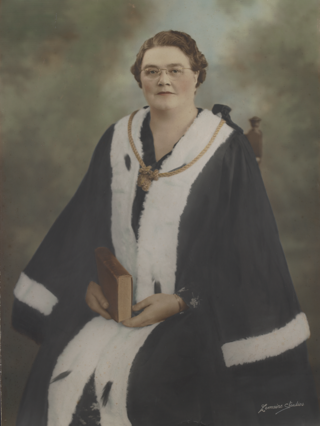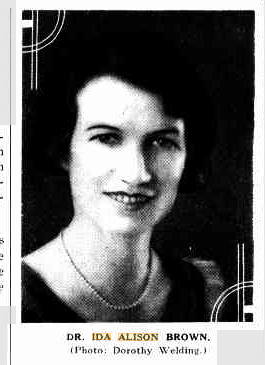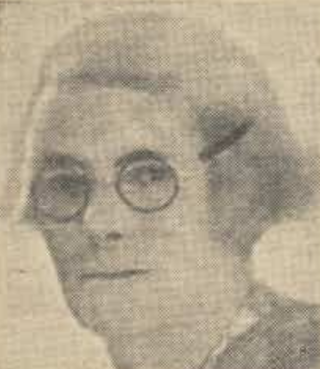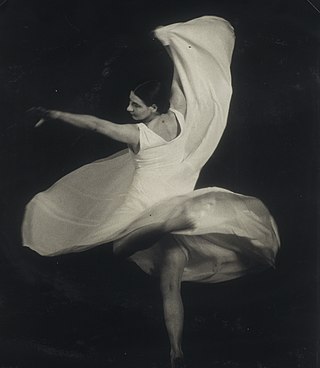
Georgina King (1845-1932), was an Australian geologist and anthropologist.

Georgina King (1845-1932), was an Australian geologist and anthropologist.
Georgina King was born on 6 June 1845 in Fremantle, Western Australia, to George King, a Church of England clergyman from Ireland, and his wife Jane Mathewson. [1] She is their second daughter, and her brother Kelso King would also bring acclaim to the family. [2] In 1849, her family moved to Sydney. King's father, a fellow of St Paul's College, oversaw her education and encouraged her to read widely including books on evolution and natural history. It is in Sydney where she developed her interest in fossils, first introduced to her by a clergyman and amateur geologist named William Branwhite Clarkson. Later on, her family doctor, George Bennett, a keen naturalist, recommended texts on geology for her to read. So, like many of the young women during the 19th century, she was educated from home. Discouraged by her father and Bennett from marrying, King looked after a nephew and niece at Springwood from the 1870s until 1881, and then travelled to Britain and Europe. [1] She experienced a significant amount of hardship in her years working geology. Often like she was being taken advantage of or not being taken seriously enough in an industry dominated by males. Eventually she wrote two autobiographies before her death in 1932.
After returning to Australia, King was active in the Women's Literary Society, [3] which was founded in 1889, along with friend Rose Scott. [1] King was an original member of the Women's Club. In 1888, King attended the inaugural meeting of the Australasian Association for the Advancement of Science (AAAS). She met many distinguished scientists through this meeting and later corresponded with R. L. Jack, who had done extensive geological surveys of Queensland and (Sir) Frederick McCoy of Victoria. Recalling the geological history she had been taught in her youth, and inspired by the work of McCoy and others, King proposed a 'Tertiary Period Catastrophism' theory to the wider scientific community. [1] [4] When her paper on this theory was rejected by the Royal Society of New South Wales in 1892, King sent them to be published in newspapers like the Sydney Morning Herald. [5] Similarly she sent her papers to the University of Sydney and other scientists to consider. Her controversial ideas and claims to theories posed by other scientists, led to further ridicule.
King collected botanical specimens (at least 295) for Ferdinand von Mueller, from the Blue Mountains (1892-1893, 1895, 1897), Port Jackson (1893-1896), and various other parts of New South Wales and Queensland. She collected the type specimen of Pultenaea subternata . [6] She traveled to study rock formations in Ireland, England, and other parts of Europe in the early 1880s. [7]
King published papers on anthropological subjects after 1900. She used some of her father's work on Aborigines to expand her ideas, and continued to elaborate on her geological theory of evolution. [1] She was elected a fellow of the Royal Anthropological Society of Australasia, and published within its journal, Science of Man. From 1913 King corresponded with and financially supported, Daisy Bates, [8] another woman who felt frustrated by the scientific establishment. [1] [4]
King volunteered with the Red Cross during World War I. She made dolls for patients of the Royal Alexandra Hospital for Children and was a prolific letter writer to the daily newspapers. [1]
King died on 7 June 1932 at Darling Point, Sydney, and was cremated. [1] [9]
King donated many specimens of natural science to the Australian Museum and Technological Museum of Sydney. She also donated over 300 specimens to the National Herbarium of Victoria. [10] Her papers are held by the State Library of New South Wales. [11]
King was part of the women's club of Sydney that was a club of women with interests in science, art and public and private work. Eventually leading to her making the Tertiary Period Catastrophism theory describing that mineral deposits on geological structures were caused by heat, magnetism, and electric that created volcanic action. King believed that other scientists were trying to steal her ideas such as her idea of Tertiary Period Catastrophism. Believing that Edgeworth David and E. F. Pittman wished to claim it as their own when it was rejected in 1892 by the Society of New South Wales. Thinking that Einstein had stolen ideas of relativity she had created. Kings eventually reached out to T. H. Huxley in order to get a response to her theories, one of these theories being that diamonds were once marine organisms. [12]
King was an author of numerous pamphlets including, "The Mineral Wealth of New South Wales", "The Discovery of Gold and How It Was Found", "Two Stone Ages, Australia", and "The Antiquities of the Australian Aborigines" these appearing in the Sydney Morning Herald. [13] Nearly 300 of King's specimens are currently located at The National Herbarium of Victoria. [7]
In 2012 Wakefield Press published a biography of King, Ginger for Pluck: The life and times of Miss Georgina King, by Jennifer M. T. Carter and Roger Cross. [14]

John Archibald McCallum was an Australian school teacher and politician, Senator for New South Wales.

Elizabeth Lilian Maud Fowler MBE, JP was an Australian politician. She was Australia's first female mayor, serving as mayor of Newtown, New South Wales, from 1937 to 1939. She later represented the seat of Newtown in the New South Wales Legislative Assembly from 1944 to 1950. She had a long involvement with the Lang Labor faction of the Australian Labor Party (ALP), which had evolved into a separate party by the time of her election to Parliament.
Margel Ina Harris Hinder was an Australian-American modernist sculptor, noted for her kinetic and public sculptural works. Her sculptures are found outside the Australian Reserve Bank building in Martin Place, Sydney, in a memorial in Newcastle, New South Wales, and in Canberra, ACT. Her work is held in several Australian public collections.
Germaine Anne Joplin was an Australian geologist and winner of the Clarke Medal in 1963.
The Agent-General for New South Wales is the representative of the State of New South Wales in the United Kingdom who is responsible for the promotion of New South Wales' trade and economic interests in the United Kingdom, Europe and Israel. The holder is a state government public servant, as part of the Investment NSW agency, and also concurrently serves as New South Wales' Senior Trade and Investment Commissioner for Europe and Israel.

Lucy Edith Gullett was an Australian medical practitioner and philanthropist. She was a founder of the Rachel Forster Hospital in Sydney.

Charles Gilbert Heydon was an Australian politician and judge.
Elaine Alys Haxton, AM was an Australian painter, printmaker, designer and commercial artist.

Ida Alison Browne was an Australian geologist, petrologist and paleontologist at the University of Sydney.
Early Australian female aviators were generally active since 1927 when it became possible for an Australian woman to hold a pilot's licence and fly within Australia. Women had participated in gliding, or taken a licence overseas, but they had not been permitted to fly a plane under licence within Australia. The first Aero Club in Australia was established in 1915.

Dora Wilcox, was a New Zealand and Australian poet and playwright.

Sarah (Sally) Hynes was a Kingdom of Prussia-born, Australian botanist and teacher.

Marguerite Ludovia Dale was an Australian playwright and feminist.

Ella May McFadyen was an Australian poet, journalist and children's writer. For 18 years she conducted "The Children's Page" for The Sydney Mail and was known as Cinderella.

Mary Stoddard, was a Scottish-born artist who spent twenty years in Australia and was known for her still life paintings, miniatures and full-size portraits, including two of Sir Henry Parkes.

Irene Vera Young, born Irene Vera Carter, was an Australian dancer and dance educator.
Anna Fligg, known as Anny Fligg or Annie Fligg, was a German dancer and dance educator, who taught the methods of Rudolf von Laban in London and in Australia in the 1930s.

Jessie Urquhart was an Australian journalist, novelist and short-story writer.
Caroline Tennant-Kelly (1899–1989) was an Australian theatre producer, Aboriginal rights activist and anthropologist.
Helen Plummer Phillips (1850–1929) was an educator, missionary, and philanthropist. She was the first missionary sent from Australia by the newly formed Church Missionary Association NSW in 1892. She was the first tutor for women students at the University of Sydney and formed the University of Sydney Women's Society in 1891 and established its settlement work, mentoring the women students until the Women's College was built and the first principal arrived. Phillips was a principal of St. Catherine's School, Waverley NSW, an advocate for women's full education, and a benefactor of St Luke's Anglican Community Church, Medlow Bath, NSW.
{{cite book}}: |work= ignored (help){{citation}}: |author2= has generic name (help)CS1 maint: multiple names: authors list (link)